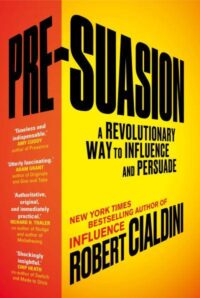Reading Notes for:


“The Focusing Illusion,”: “Nothing in life is as important as you think it is while you are thinking about it.”
After recognizing the extent of our vulnerability to the focusing illusion, I’ve come at last to appreciate a standard saying of Hollywood press agents: “There’s no such thing as bad publicity.”
Powerful publicity of any sort spares them that worst of all fates because it brings them attention; and raw attention anoints them with presumed importance. Especially in the arts, where one’s worth is almost entirely subjective, an elevated public presence contributes to that worth.
Thus, the persuader who artfully draws outsize attention to the most favorable feature of an offer becomes a successful pre-suader. That is, he or she becomes effective not just in a straightforward attention-based way—by arranging for audiences to consider that feature fully—but also by arranging for them to lend the feature exaggerated significance even before they have examined it. When audience members do then consider it fully, they experience a double-barreled effect. They are likely to be convinced that the attribute is especially desirable by the one-sidedness of the evidence they’ve been directed toward and to view that attribute as especially important besides.
Focused attention leads celebrities and audiences to overestimate the celebrities’ importance.
BACK ROADS TO ATTENTION
It is rousing and worrisome (depending on whether you are playing offense or defense) to recognize that these persuasive outcomes can flow from attention-shifting techniques so slight as to go unrecognized as agents of change. Let’s consider three ways communicators have used such subtle tactics to great effect.
Managing the Background
“A traditional problem that the business-savvy students in our marketing courses raise all the time,” she said. “We always instruct them not to get caught up in a price war against an inferior product, because they’ll lose. We tell them to make quality the battleground instead, because that’s a fight they’ll most likely win.
‘Yeah, but how?’
In an article largely overlooked since it was published in 2002, they described how they were able to draw website visitors’ attention to the goal of comfort merely by placing fluffy clouds on the background wallpaper of the site’s landing page. That maneuver led those visitors to assign elevated levels of importance to comfort when asked what they were looking for in a sofa.
To make sure their results were due to the landing page wallpaper and not to some general human preference for comfort, Mandel and Johnson reversed their procedure for other visitors, who saw wallpaper that pulled their attention to the goal of economy by depicting pennies instead of clouds. These visitors assigned greater levels of importance to price, searched the site primarily for cost information, and preferred an inexpensive sofa.
Additional research has found similarly sly effects for online banner ads—the sort we all assume we can ignore without impact while we read.
While reading an online article about education, repeated exposure to a banner ad for a new brand of camera made the readers significantly more favorable to the ad when they were shown it again later. Tellingly, this effect emerged even though they couldn’t recall having ever seen the ad, which had been presented to them in five-second flashes near the story material. Further, the more often the ad had appeared while they were reading the article, the more they came to like it. This last finding deserves elaboration because it runs counter to abundant evidence that most ads experience a wear-out effect after they have been encountered repeatedly, with observers tiring of them or losing trust in advertisers who seem to think that their message is so weak that they need to send it over and over. Why didn’t these banner ads, which were presented as many as twenty times within just five pages of text, suffer any wear-out? The readers never processed the ads consciously, so there was no recognized information to be identified as tedious or untrustworthy.
Indeed, it looks to be this third result (lack of direct notice) that makes banner ads so effective in the first two strong and stubborn ways.
